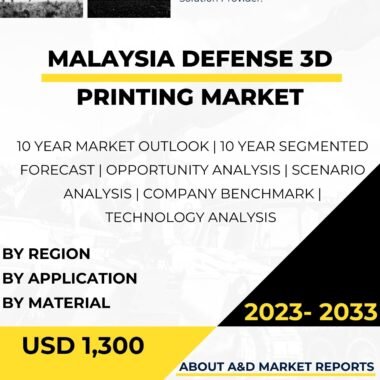Description
The 3D printing market in Singapore’s defense sector has experienced significant growth and development in recent years, reflecting the country’s commitment to embracing innovative technologies to enhance its defense capabilities. 3D printing, also known as additive manufacturing, offers unique advantages in the defense industry, providing rapid prototyping, cost-effective production, and customization of complex parts and components.
As a small and highly advanced nation in Southeast Asia, Singapore recognizes the importance of technological innovation in maintaining a strong and modern defense force. 3D printing plays a pivotal role in Singapore’s strategy to leverage cutting-edge technologies to bolster its defense capabilities and meet the challenges of a rapidly evolving security landscape.
The adoption of 3D printing in Singapore’s defense sector is driven by several factors, including cost-effectiveness, design flexibility, and reduced lead times. By employing 3D printing, Singapore’s defense industry can manufacture parts and components on-demand, reducing the need for extensive inventories and mitigating supply chain disruptions.
The Republic of Singapore Armed Forces (SAF) actively invests in 3D printing technologies to streamline its logistics, maintenance, and sustainment operations. The SAF uses 3D printing to produce spare parts, tools, and equipment in remote locations or on the battlefield, reducing downtime and enhancing the readiness of its assets.
One of the prominent applications of 3D printing in Singapore’s defense sector is the production of drone components. Unmanned aerial vehicles (UAVs) play a crucial role in modern military operations, and 3D printing enables the rapid fabrication of lightweight and high-performance drone parts, such as airframes and propulsion systems.
Moreover, 3D printing offers significant advantages in the customization of individual soldier equipment and personal protective gear. This technology allows for the creation of tailored solutions that improve soldier comfort and mobility while enhancing their effectiveness on the battlefield.
Singapore’s commitment to technological innovation and indigenous defense production extends to the development of its 3D printing capabilities. The country actively invests in research and development initiatives to develop advanced 3D printing technologies, materials, and processes tailored to defense requirements.
Singapore also collaborates with international defense companies and research institutions to access cutting-edge 3D printing technologies and expertise. These partnerships enable Singapore to stay at the forefront of additive manufacturing and benefit from global innovation in the defense 3D printing market.
The integration of 3D printing into Singapore’s defense industry aligns with the country’s focus on sustainability and reduced environmental impact. Additive manufacturing generates less waste compared to traditional manufacturing processes, contributing to Singapore’s efforts to promote eco-friendly practices in its defense operations.
In addition to its operational benefits, 3D printing also fosters creativity and ingenuity within Singapore’s defense industry. Engineers and designers can explore novel solutions and push the boundaries of design possibilities, leading to innovative products and enhanced defense capabilities.
Singapore’s investment in 3D printing technology has not been limited to domestic applications. The country’s defense industry actively participates in international defense exhibitions and forums, showcasing its indigenous 3D printing capabilities and strengthening its position as a reliable defense partner in the global market.
The continued advancement of 3D printing in Singapore’s defense sector necessitates the development of new training programs and operational doctrines. As 3D printing becomes an integral part of defense logistics and maintenance, Singapore’s armed forces adapt their procedures and capabilities to fully leverage the benefits of additive manufacturing.
In conclusion, the 3D printing market in Singapore’s defense sector has experienced significant growth, driven by the country’s commitment to embracing innovative technologies to enhance its defense capabilities. 3D printing offers unique advantages in the defense industry, including rapid prototyping, cost-effective production, and customization of complex parts and components.
Singapore recognizes the strategic importance of 3D printing in streamlining logistics, maintenance, and sustainment operations, and actively invests in research and development initiatives to develop advanced 3D printing technologies tailored to defense requirements.
The integration of 3D printing aligns with Singapore’s focus on sustainability and reduced environmental impact, contributing to the country’s efforts to promote eco-friendly practices in its defense operations.
Singapore’s investment in 3D printing fosters creativity and ingenuity within its defense industry, encouraging engineers and designers to explore novel solutions and push the boundaries of design possibilities.
The country’s participation in international defense exhibitions and forums highlights its indigenous 3D printing capabilities and strengthens its position as a reliable defense partner in the global market.
As 3D printing continues to advance, Singapore’s defense industry will continue to benefit from this transformative technology, driving innovation and enhancing defense capabilities in the face of evolving security challenges.




